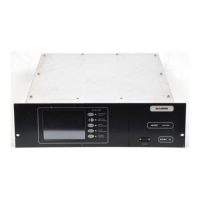G.2.3.1. Checking Gate Drive
Apply low voltage only to the transmitter.
Make sure the transmitter is off by depress-
ing the OFF pushbutton.
Use an oscilloscope to check the PDM
drive signals across R21, R22, R41, and
R42onthePDMAmplifiersA6thruA9.
There should be a 15 volt peak-to-peak 60
kHz pulse at each of the eight locations
(only two PDM Amplifiers are used in a
GATES ONE or TWO).
If the gate drive is missing on any of the
resistors listed, it will be necessary to trace
the signal backwards through the amplifier
to find where it has been lost. The PDM
pulses should not change visibly as theyare
traced fromthe PDM Generatorto the gates
of the PDM Amplifier transistors.
G.3. Handling MOSFET’s
Due to the fragile nature of the gate of a
MOSFET, special care in their handling is
required. The gate junction may be de-
stroyedby staticelectricityif thestatic elec-
tricity is allowed to discharge through the
MOSFET. For example, walking across a
carpet to pick up a MOSFET that is not
protected by antistatic packaging could re-
sult in the destruction of the MOSFET. A
static charge could build up on a person as
they walk across the carpet. This static
charge will eventually have to be dis-
charged. Discharging to the MOSFET
could damage the MOSFET.
NOTE
MOSFET transistors which are in circuit
in the GATES Series™ transmitters are
immune to this damage.
The MOSFET transistors are shipped in
antistatic packaging. The transistors should
remain in this packaging until they are to be
used or tested.
G.4. Testing MOSFET’s
The MOSFET’s used in the GATES Se-
ries™ transmitters may be checked with an
ohmmeter. However there is a requirement
which restricts the use of some ohmmeters.
If the battery voltage is too low (under 3V)
ortoo high(over20V)theohmmetercannot
be used. A battery voltage less than 3V will
not give an operational check of the transis-
tor and a battery voltage greater than 20V
may resultin damage to the transistor under
test. A Simpson 260, which uses a 9V bat-
tery on the Rx10k scale works quite well.
The following test applies to all MOS-
FET’s used in the transmitter, but is not
necessarily applicable to MOSFET’sused
in other equipment.
This test will show how a MOSFET can
be switched “on” and
“off” by charging and discharging the gate
of the MOSFET.
Refer to Figure G-4 for the following test.
Connect the positive lead of the ohmme-
ter to the source of the transistor. Momen-
tarily connect the negative lead to the gate
and then connect it to the source. Then
connect the positive lead to the drain (case).
The ohmmeter should read at least 2 me-
gohms.
Remove the positive lead from the case
and momentarily touch it to the gate. Re-
connect the positive lead to the case. The
ohmmetershouldreadverynearzeroohms.
Figure G-4. Outline of MOSFET
Figure G-3
G-4 888-2314-001 Rev. AE: 03-05-2002
WARNING: Disconnect primary power prior to servicing.
